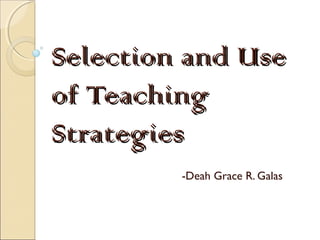
Guiding Principles for Selecting Effective Teaching Strategies
- 1. Selection and UseSelection and Use of Teachingof Teaching StrategiesStrategies -Deah Grace R. Galas
- 2. Guiding Principles in the selectionGuiding Principles in the selection and use of teaching strategiesand use of teaching strategies 1.Learning is an active process What I hear, I forget What I see, I remember What I do , I understand 2. The more senses that are involved in learning, the more and the better the learning.
- 3. Contribution of senses to learningContribution of senses to learning Sight – 75% Hearing – 13% Touch – 6% Taste – 3% Smell – 3%
- 4. 3. Emotion has the power to increase retention and learning. 4. Learning is meaningful when it is connected to student’s everyday life. 5. Good teaching goes beyond recall of information. 6. An integrated teaching approach is far more effective than teaching isolated bits of information
- 5. An Integrated approach incorporatesAn Integrated approach incorporates successful, research-based and brain-basedsuccessful, research-based and brain-based instructional strategiesinstructional strategies 1. Without rehearsal or constant attention, information remains in working memory for only about 15 to 20 seconds. This implies the need for memory aids. 2. Learning is a process of building neural networks. This network is formed through concrete experience, representational or symbolic learning, and abstract learning-the 3 levels of learning.
- 6. 3. Our brains have difficulty comprehending very large numbers because we have nothing in our experience to “hook” them to. 4. The eyes contain nearly 70 percent of the body’s sensory receptors and send millions of signals every second along the optic nerves to the visual processing of the brain. The capacity of the long-term memory for pictures seems almost unlimited.
- 7. 5. There is little doubt that when information is embedded in music or rhyme, its recall is easier than when it is in prose.
- 8. Based-Based StrategiesBased-Based Strategies 1. Involving students in real-life or authentic problem solving. 2. Using projects to increase meaning and motivation. 3. Simulations and role plays as meaning makers. 4. Classroom strategies using visual processing. 5. Songs, jingles, and raps
- 9. 6. Mnemonic strategies 7.Writing strategies 8.Active review 9.Hands-on-activities 10.There is no such thing as best teaching method. The best method is the one that works, the one that yields result.
- 10. FACTORS TO CONSIDER IN THEFACTORS TO CONSIDER IN THE CHOICE OF A TEACHING METHODCHOICE OF A TEACHING METHOD 1. The instructional objective 2. The nature of the subject matter 3. The learner 4. The teacher 5. School policies
- 11. “THE END”
